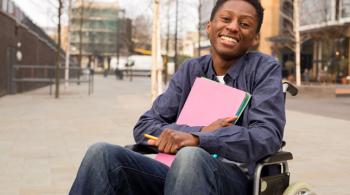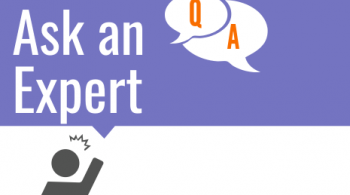By Natalie Shaheen
September 27, 2016
Natalie Shaheen is a special education teacher, trained in working with the blind. Her eclectic teaching background includes work as a classroom special educator supporting the needs of students with autism and as an itinerant teacher of the blind for students age 3-22. Natalie now works as an educational consultant, focusing on science, technology, engineering, and math (STEM) education for students with disabilities. Follow Natalie on Twitter at @nlshaheen.
When designing an inclusive learning environment, what factors should a teacher consider to ensure the environment meets the needs of blind and low vision students?
Built Environment:
First and most obvious is the built environment. For some learners with disabilities, the accessibility of the built environment is critical to inclusion. For blind students, the built environment is less often a barrier to inclusion. A few key considerations for the built environment include:
-
Protruding Objects:
When mounting large objects on the wall (e.g., floating bookshelves, display cases, anything that is more than 4 inches in depth), ask yourself two questions: (1) is the object mounted at a height that falls between the knee and head height of my students and (2) is there a piece of furniture on the floor underneath the protruding object? The Americans with Disabilities Act (ADA) provides specific height guidelines for protruding objects, but it is important to note that these guidelines are based on the height of adults. It is a good rule of thumb to say that any object below the knee is detectable by a long white cane and any object that floats on the wall between the knee and head is potentially problematic.- Rational: When a protruding object floats on a wall with nothing beneath it, a blind person who is traveling next to the wall will not be able to detect the floating object with his cane. Consequently they may bump into the object, which could be painful and will certainly be annoying.
- Learn more: Check out the “protruding objects” animation from the U.S. Access Board.
-
Labeling:
Braille signage is a requirement of the ADA; the placard outside of your classroom hopefully provides the room number in Braille and print. But what about all of the other labels and signs we put up in classrooms? Is there a sign in your classroom that labels the reading center? Do you label the storage bins for common classroom materials (e.g., crayons, glue, etc.) with print labels, pictures, or symbols? If so, adding Braille, large print, and/or tactile symbols will make your learning environment more inclusive of blind students. In my classroom, for example, the bin where the crayons were stored was labeled in print, Braille, and a real crayon was hot glued to the outside.- Rational: A young sighted child would have to work really hard not to see print in her environment each day, because print is just about everywhere; however a young blind student has the opposite experience and rarely comes across Braille in their environment. There is no Braille on the cereal box, the mail that mom is reading, or the bulletin boards in the hallways at school. By being intentional about adding Braille to print labels that exist in our classrooms, we provide early Braille readers with the same learning opportunities as their sighted peers.
-
Organization and Predictability:
In addition to tactile labels, keeping materials organized and in a consistent location will facilitate blind students’ independent retrieval and clean-up of common classroom tools. While it is essential for blind students, organization and predictability is helpful for all students.
Digital Environment:
In today’s classroom, the digital environment is also a critical factor. It is important to know that just as built environments can be inaccessible to some students so, too, can digital environments. If you use technology in your classroom and want your learning environment to be inclusive, take time to make sure the technology you use is accessible to students with disabilities. The best benchmark for digital accessibility is the Web Content Accessibility Guidelines (WCAG) 2.0. Two key concepts form WCAG 2.0:
-
Perceivable:
Are there pictures or other visuals in the technology you use? Are there nonvisual alternatives for blind students? A picture can be described in words or made into a tactile graphic for a blind student. A video can be described to provide blind students access to content that is purely visual. -
Operable:
Blind people primarily navigate the computer using the keyboard. Does the technology facilitate keyboard navigation? There are free, automated tools that can look for this functionality on websites.
Learn More: The WebAIM website has a wealth of easy-to-understand information about technology accessibility.
Classroom Culture:
The cultural norms of a classroom are also an important aspect of an inclusive learning environment,as cultivating a few cultural norms in your classroom will make the environment more inclusive to blind students.
-
Descriptive language:
Words like “there”, “this”, and “that”, which are commonly paired with a gesture, do not provide blind people with sufficient information.- Inaccessible: The trashcan is over there.
- Accessible: The trashcan is to the left of the door.
- Inaccessible: (When discussing fractions) This over that equals that.
- Accessible: If there is a two in the numerator and a four in the denominator it equals one half.
- Inaccessible: These are the materials that you can use for today’s activity.
- Accessible: The materials that are available for this activity are: crayons, construction paper, and glue.
-
Seeking the Floor (or requesting to participate):
Raising a hand to seek the floor is something a blind student can do, but she cannot see who else has raised a hand to seek the floor. In my classroom, students raise their hand and softly say their name to seek the floor. This provides both a visual and nonvisual cue about who is seeking the floor and also provides opportunities for students to learn each other’s names at the beginning of the school year.
Learn More: Some of the cultural norms that I have tried to foster in my classroom are discussed in the following article:If you want to learn more about blind students and their lives in and out of school, I recommend the free magazine Future Reflections, which is published by the National Federation of the Blind.















